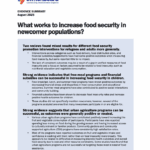The aim of our review is to critically analyze the urban agriculture and urban food systems literature in order to understand the impact of urban-produced foods on community food security. We examine the role of city planning, food policy, and civic engagement in creating spaces for urban agriculture in cities across the United States, and whether (and how) these spaces promote food justice and food security. Bringing together multidisciplinary literature on access to urban agriculture and the distribution of urban-produced foods in a thematic, systematic review, we point out gaps in the academic research that would benefit from further study. The review integrates academic literature generated from Web of Science searches with gray literature identified through Google Alerts. We find that while there is a strong focus on elucidating the multiple benefits of urban agriculture, there are few studies that robustly measure the impact of urban farms on improving food security in low-income communities. Much of the literature is theoretical, focused on the production potential of urban agriculture, while more work is needed to understand and overcome barriers to access and distribution among communities in need. We conclude with a set of recommendations for researchers, practitioners, and policymakers who seek to create spaces in cities for food justice, equity, access, and sovereignty.
The management of volunteers – What can human resources do? A review and research agenda
There is an increasing interest from scholars and practitioners in understanding how non-profit organizations can design and implement human resources (HR) practices to enhance desirable volunteer attitudes and behaviors. This paper presents a comprehensive overview of existing studies on the relationship between HR practices and volunteering outcomes. We use the ability-motivation-opportunity model as a guiding…

